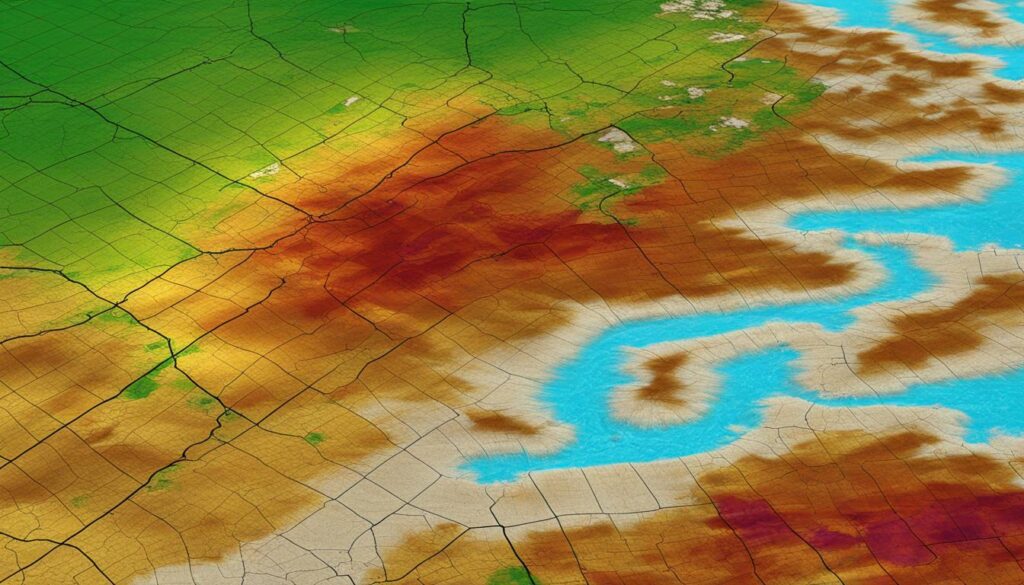When it comes to drought monitoring, assessment, and analysis, understanding the various drought severity indices is crucial. These indices provide valuable insights into the severity and impact of drought conditions. In this article, we will explore the difference between two prominent drought severity indices: the United States Drought Monitor (USDM) and the Drought Severity and Coverage Index (DSCI).
The USDM takes a comprehensive approach to classify and assess drought severity by incorporating physical indicators such as precipitation data, climate and weather inputs, and hydrology information. It distinguishes between short-term drought, which affects agriculture and grasslands, and long-term drought, which has broader implications for hydrology and ecology. On the other hand, the DSCI is an experimental method that converts categorical drought levels into a single continuous variable, allowing for easier comparison and interpretation of drought severity over time.
In the following sections, we will delve deeper into the classification, impacts, and calculation methods of these indices. We will also explore how the DSCI values can be used to track drought conditions over time and interpret spatial and temporal trends in drought severity.
Key Takeaways:
- The USDM and the DSCI are two prominent drought severity indices.
- The USDM classifies and assesses drought severity based on various physical indicators.
- The DSCI converts categorical drought data into a single continuous variable for easier comparison.
- Both indices play crucial roles in understanding and managing the impacts of drought.
- Tracking drought conditions and interpreting trends can be done using the DSCI values.
Short-Term Drought Classification and Impacts
The United States Drought Monitor (USDM) uses a comprehensive approach to differentiate between short- and long-term drought. Short-term drought, classified as S, typically lasts for less than 6 months. It has immediate impacts on agriculture and grasslands, making it crucial to understand its classification and implications.
Short-term drought classification can rapidly change based on precipitation and other factors. The USDM employs a convergence of evidence approach, taking into account objective physical indicators, inputs from local experts, condition observations, and reports of drought impacts. This methodology helps determine the intensity of short-term drought and enables effective monitoring and mitigation strategies.
Short-term drought poses significant challenges to agricultural activities and grasslands. The lack of water availability during a short-term drought can have detrimental effects on crop production and livestock. It also negatively impacts grasslands, leading to reduced forage availability for grazing animals. Effective management and timely interventions are essential to minimize the economic and environmental consequences associated with short-term drought.
Short-Term Drought Classification and Impacts
Drought classification: S (typically lasts for less than 6 months)
Impacts:
- Reduced crop production
- Decreased forage availability for grazing animals
- Increased water scarcity
- Diminished soil moisture
Understanding the classification and impacts of short-term drought is essential for implementing effective strategies to mitigate its consequences in agriculture and grassland management.
Table: Short-Term Drought Impacts on Agriculture and Grasslands
| Impact | Description |
|---|---|
| Reduced crop production | Dry conditions negatively affect soil moisture, leading to lower crop yields. |
| Decreased forage availability for grazing animals | Lack of rain and dry conditions limit grass growth, reducing available forage for livestock. |
| Increased water scarcity | Short-term drought intensifies competition for limited water resources, affecting irrigation and water availability for agricultural activities. |
| Diminished soil moisture | Dry weather conditions reduce soil moisture, impacting plant growth and nutrient absorption. |
Long-Term Drought Classification and Impacts
Long-term drought, designated as L by the USDM, persists for more than 6 months and has deeper impacts on hydrology and ecology. Even with short-term gains in precipitation, long-term drought can continue to affect water resources and ecosystems. The USDM incorporates climate, weather, and hydrology inputs across different time spans to assess the severity of long-term drought. It relies on a convergence of evidence approach, considering various data sources and expert judgment to determine the classification of long-term drought.
Understanding the impacts of long-term drought on hydrology and ecology is crucial for effective drought management. Hydrology refers to the study of water in the environment, including its movement, distribution, and availability. During long-term drought, water sources such as rivers, lakes, and groundwater reservoirs can become depleted, leading to a decrease in water availability for human activities and natural ecosystems. This reduction in water resources can have severe consequences, including conflicts over limited water supplies, reduced agricultural productivity, and harm to aquatic habitats and wildlife populations.
Ecology, on the other hand, focuses on the relationships between organisms and their environments. Long-term drought can disrupt ecosystems by altering the balance of species interactions and reducing the availability of essential resources like water and food. Plants and animals that depend on specific hydrological conditions may struggle to survive and reproduce during extended periods of drought. This can lead to changes in species composition, reduced biodiversity, and long-term ecological damage. Understanding the ecological impacts of long-term drought is essential for conservation efforts and sustainable management of natural areas.
| Impacts of Long-Term Drought | Hydrology | Ecology |
|---|---|---|
| Depletion of water sources | X | – |
| Decreased water availability | X | – |
| Conflicts over limited water supplies | X | – |
| Reduced agricultural productivity | X | – |
| Harm to aquatic habitats and wildlife populations | X | – |
| Disrupted species interactions | – | X |
| Reduced biodiversity | – | X |
| Long-term ecological damage | – | X |
Drought Severity and Coverage Index (DSCI)
The Drought Severity and Coverage Index (DSCI) is a valuable tool used by the United States Drought Monitor (USDM) to measure and assess drought severity. The DSCI provides a continuous variable that converts categorical drought data into a single value, offering a comprehensive view of drought conditions across different areas. It allows for a better understanding and comparison of drought severity over time.
With DSCI, each area is assigned a numerical value ranging from 0 to 500, indicating the level of abnormally dry or drought conditions. A value of 0 represents no drought, while a value of 500 signifies exceptional drought throughout the area. This index provides a standardized measurement that facilitates the analysis and interpretation of drought severity.
The calculation of DSCI can be done using either cumulative or categorical Drought Monitor data. The cumulative approach involves adding the percentages of each drought category (D0 to D4) for a given week to obtain the DSCI value. On the other hand, the categorical approach uses weighted sums of the percentages in each category. Both methods provide a comprehensive assessment of drought severity and enable the tracking of drought conditions over time.
To illustrate the effectiveness of the DSCI, consider the following table, which showcases the values for a specific region over a 12-week period:
| Week | DSCI Value |
|---|---|
| Week 1 | 100 |
| Week 2 | 150 |
| Week 3 | 200 |
| Week 4 | 250 |
| Week 5 | 300 |
| Week 6 | 350 |
| Week 7 | 400 |
| Week 8 | 450 |
| Week 9 | 490 |
| Week 10 | 500 |
| Week 11 | 500 |
| Week 12 | 500 |
As shown in the table, the DSCI value increases gradually from 100 to 350 over the first six weeks, indicating a worsening drought condition. The severity intensifies significantly from week 7 onwards, reaching the maximum value of 500 and remaining at that level until the end of the observation period. This example demonstrates how the DSCI can provide insight into the progression and intensity of drought over time.
DSCI Calculation
The Drought Severity and Coverage Index (DSCI) is a valuable tool for assessing and comparing drought severity over time. There are two methods for calculating the DSCI: the cumulative approach and the categorical approach.
In the cumulative approach, the DSCI is obtained by adding the percentages of each drought category (D0 to D4) for a given week. This method provides a straightforward way to determine the overall severity of drought in a specific area.
The categorical approach, on the other hand, uses weighted sums of the percentages in each category to calculate the DSCI. This approach takes into account the relative importance of each category and provides a more nuanced assessment of drought severity. Both methods allow for the conversion of USDM data from categorical to continuous, providing a comprehensive view of drought severity.
Comparison of Cumulative and Categorical DSCI Calculation
| Drought Category | Cumulative DSCI Calculation | Categorical DSCI Calculation |
|---|---|---|
| D0 | 10% | 0.5 |
| D1 | 20% | 1 |
| D2 | 30% | 2.5 |
| D3 | 25% | 5 |
| D4 | 15% | 10 |
“The cumulative approach provides a simple way to calculate the DSCI by summing the percentages of each drought category. However, the categorical approach offers a more nuanced assessment by considering the relative importance of each category. Both methods are valuable for understanding and comparing drought severity over time.”
By utilizing the DSCI calculation, researchers and decision-makers can assess how drought severity changes, compare different drought events, and analyze spatial and temporal trends. This information is crucial for effective drought monitoring, assessment, and management.

Interpreting DSCI Over Time
Understanding the Drought Severity and Coverage Index (DSCI) is crucial for monitoring and assessing drought conditions. The DSCI provides a continuous variable that represents the severity of drought across different areas. Interpreting the DSCI over time allows us to track drought trends and gain insights into the spatial and temporal patterns of drought severity.
One way to interpret the DSCI is by averaging the values over a specific period. This provides an overall picture of drought severity in the region. By comparing the average DSCI values over different timeframes, we can observe whether drought conditions are improving or worsening.
Another approach is to sum the DSCI values for specific events or periods. This helps us compare different drought events and understand their magnitude and duration. By analyzing the sum of DSCI values for multiple events, we can identify which drought episodes were the most severe and assess their impact on the affected areas.
It’s important to note that the DSCI values may vary across different regions, even within the same timeframe. Localized drought conditions can result in higher or lower DSCI values for smaller areas. Therefore, it’s essential to consider the context and specific geography when interpreting the DSCI.
To illustrate the changes in drought severity over time, the table below presents the average DSCI values for three consecutive years in a specific region:
| Year | Average DSCI |
|---|---|
| 2020 | 200 |
| 2021 | 250 |
| 2022 | 180 |
The table shows that the average DSCI increased from 200 in 2020 to 250 in 2021, indicating a worsening drought condition. However, in 2022, the average DSCI decreased to 180, suggesting an improvement in drought severity compared to the previous year.
By analyzing historical DSCI data and comparing it with other relevant factors such as precipitation patterns, water availability, and ecological impacts, we can gain valuable insights into drought trends and make informed decisions regarding drought mitigation and resource management strategies.
https://www.youtube.com/watch?v=HgKrF26PtaA
Impact of Drought Severity
The severity of drought can have significant consequences on various aspects of society. It affects agriculture, water resources, ecosystems, and even human health and well-being. Understanding the interpretation of DSCI over time helps policymakers, researchers, and communities assess the impact of drought and devise appropriate measures to mitigate its effects.
Conclusion
Understanding the difference between drought severity indices is crucial for effective drought monitoring and assessment. The United States Drought Monitor (USDM) provides a comprehensive classification of short- and long-term drought, taking into account various physical indicators and expert input. On the other hand, the Drought Severity and Coverage Index (DSCI) converts categorical drought data into a single continuous variable, allowing for easier comparison and interpretation of drought severity over time.
By utilizing a convergence of evidence approach, the USDM considers precipitation data, climate and weather inputs, and hydrology information to classify and assess drought severity. It also provides the DSCI, which ranges from 0 to 500, representing the severity of drought conditions across an area. This index offers a convenient way to analyze spatial and temporal trends in drought severity.
Both the USDM and the DSCI play crucial roles in understanding and managing the impacts of drought. While the USDM focuses on differentiating between short- and long-term droughts and assessing their specific impacts on agriculture, grasslands, hydrology, and ecology, the DSCI provides a continuous variable that allows for a comprehensive view of drought severity. By combining these indices, policymakers, researchers, and stakeholders can gain valuable insights into drought conditions and make informed decisions to mitigate their effects.
FAQ
What is the difference between the United States Drought Monitor (USDM) and the Drought Severity and Coverage Index (DSCI)?
The USDM is a comprehensive classification system that assesses both short- and long-term drought using various physical indicators and expert input. The DSCI, on the other hand, is an experimental method that converts categorical drought data into a single continuous variable for easier comparison and interpretation of drought severity over time.
How does the USDM classify short-term drought?
Short-term drought, designated as S by the USDM, typically lasts for less than 6 months and has immediate impacts on agriculture and grasslands.
How does the USDM classify long-term drought?
Long-term drought, designated as L by the USDM, persists for more than 6 months and has deeper impacts on hydrology and ecology.
What is the Drought Severity and Coverage Index (DSCI)?
The DSCI is an experimental method used by the USDM to convert categorical drought levels into a single continuous variable for each area, ranging from 0 to 500.
How is the DSCI calculated?
The DSCI can be calculated using either cumulative or categorical Drought Monitor data. The cumulative approach involves adding the percentages of each drought category for a given week, while the categorical approach uses weighted sums of the percentages in each category. Both methods provide a comprehensive view of drought severity.
How can the DSCI be used to track drought conditions?
The DSCI values can be averaged to provide an overall picture of drought severity and summed to compare different drought events. However, it’s important to note that smaller areas may have higher or lower DSCI values due to localized drought conditions.
What is the importance of understanding drought severity indices?
Understanding drought severity indices like the USDM and the DSCI is essential for effective drought monitoring, assessment, and management of the impacts of drought.



